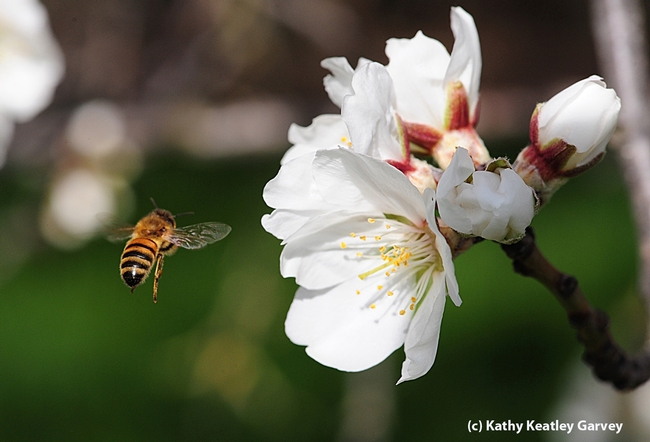- Author: Kathy Keatley Garvey
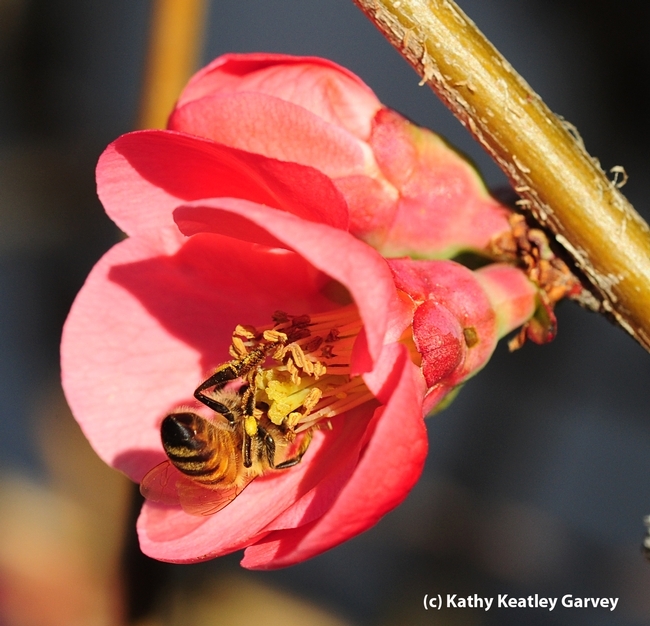
What is the UC Davis Biodiversity Museum Day?
It's a free, open-to-the-public, science-based day that annually takes place the Saturday of Presidents' Day weekend and showcases nearly a dozen museums or collections. It's an opportunity for campus visitors to see exhibits and displays at various points on campus and converse with the scientists.
This year is the 11th annual. However, due to COVID-19 pandemic restrictions and UC Davis policies, the 2022 Biodiversity Museum Day will be held at one site--the UC Davis Conference Center, 550 Alumni Lane--and will be from 11 a.m. to 3 p.m., Sunday, March 6. What's also different? It's geared for undergraduates and other members of the UC Davis community instead of the general public from surrounding counties. (The general public can look forward to the UC Davis Picnic Day on April 23, 2022 when many of the same museums and collections are scheduled to be featured.)
Participating collections at the UC Davis Biodiversity Museum Day include, but are not limited to, the Bohart Museum of Entomology, Häagen-Dazs Honey Bee Haven, Arboretum and Public Garden, Museum of Wildlife and Fish Biology, California Raptor Center, Paleontology Collections, Botanical Conservatory, Center for Plant Diversity, Nematode Collections, and Department of Anthropology Museum.
At the March 6th event, COVID guidelines for UC Davis, Yolo County and the state of California--including appropriate mask wearing, UC Davis symptom surveys, vaccination records or negative COVID tests--will be followed.
But back to "bee my valentine."
Honey bees are an integral to at least three of the museums/collections:
- The Bohart Museum of Entomology, part of the UC Davis Department of Entomology andNematology, houses a worldwide collection of eight million insect specimens, including honey bees, bumble bees, sweat bees and more. The insect museum is located in Room 1124 of the Academic Surge Building on Crocker Lane, but it's currently closed to the public due to COVID pandemic.
- The Häagen-Dazs Honey Bee Haven, a half-acre bee garden operated by the UC Davis Department of Entomology andNematology, is located next to the Harry H. Laidlaw Jr. Honey Bee Research Facility on Bee Biology Road, west of the central campus. The late Robbin Thorp, distinguished emeritus professor of entomology, recorded more than 80 species of bees here.
- The UC Davis Arboretum and Public Garden is a 100-acre site that's the pride and joy of the campus community. It's frequented by nature lovers, walkers, hikers and bicyclists, among others--and bees! The 100-acre site also boasts the much applauded 100 Arboretum All-Stars.
How can you help the bees as well as other fauna and the flora associated with UC Davis Biodiversity Museum Day?
A UC Davis Crowdfunding Project is underway until 11:59 p.m., Feb. 28. Contributions from $5 on up are welcome, said project managers Tabatha Yang, education and public outreach coordinator for the Bohart Museum of Entomology, and Rachel Davis, a GATEways horticulturist and museum scientist at the UC Davis Arboretum and Public Garden.
"Donations will not only help us sustain the free, in-person event, it will enable our student interns to take science outreach to a whole new level," they said. "The goal of our event is to connect people from all walks of life to science and the biodiversity surrounding them. All donors will be recognized on the Biodiversity Museum Day social media accounts with a shout-out post."
Any amount is appreciated: $5 will get you into the Fantastic Yeasts category; $10, the Sprout (Valley Oaks) category; $25, the Bumble Bee category; and $50, the Jeweled Spider Fly category. Other categories include Atlati, California Condor, and Smilodon. The goal: $5000.
Key expenses include:
- Volunteer support ($2000)
- Event rentals ($1500)
- Event materials ($1500)
To donate, access https://bit.ly/3HPhSaA. You can be anonymous in name or contribution, or you can have your name listed on the donor wall in honor of someone, or in memory of someone.
Or you can just say "Bee my Valentine."
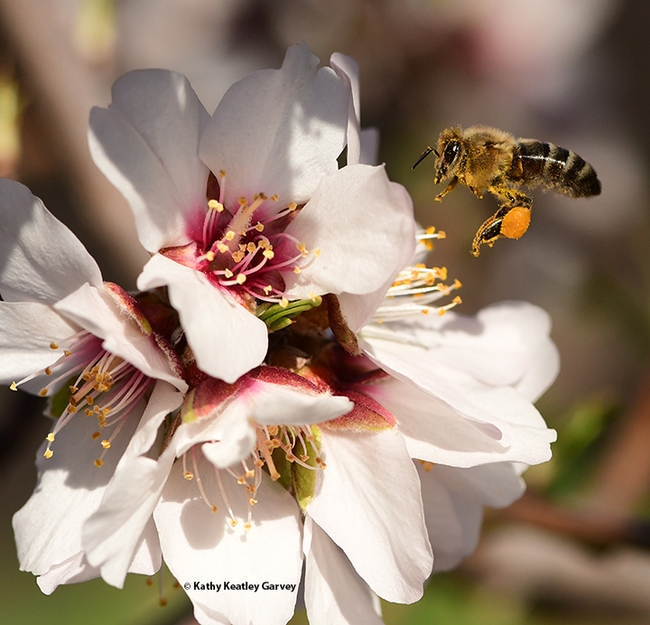
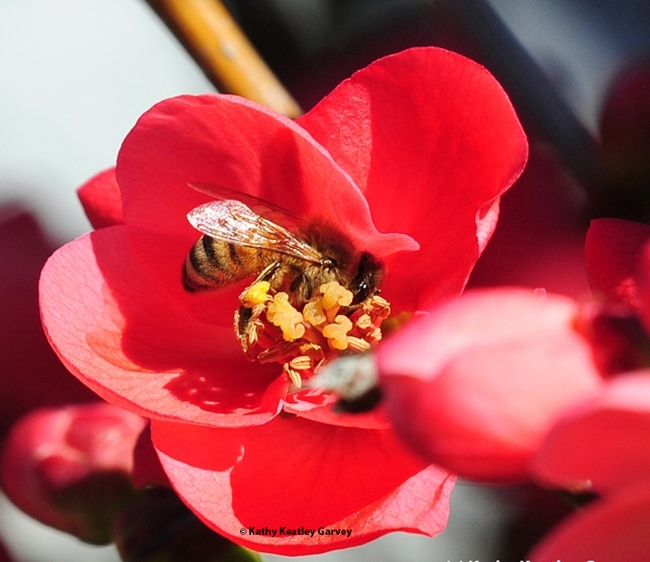
- Author: Kathy Keatley Garvey
No, it's not Valentine's Day, yet.
Yes, the almonds are blooming.
No, it's not spring.
But it looks like spring in Benicia.
The almonds are blooming in the Benicia (Calif.) State Recreation Area.
Some are on the road at the entrance to the park.
Other trees are also blooming.
Benicia resident Gordon Hough, always on the lookout for those early blooms and elusive bees, photographed a honey bee nectaring on a Bradford pear blossom (as identified by Daniel Potter, UC Davis professor of plant sciences) in the Benicia park on Monday, Jan. 21. Gorgeous image!
Benicia (or Bee-nicia?) is graced with early almond blooms. We remember heading over to the Benicia State Recreation Area on the first day of 2014 and seeing almonds in bloom. Actually, several almond trees in the parking lot were blooming on Christmas Day of 2013. (See Bug Squad)
Meanwhile, California's commercial almond pollination season usually begins around Feb. 14.
Our state has more than a million acres of almonds in production, according to Kyle Kapustka of the Almond Board of California.
The 2017 California Almond Acreage Report, from USDA's National Agricultural Statistics Service (NASS), released April 25, 2018, estimated
- 1,330,000 total almond acres in California
- 1,000,000 bearing acres in California
The 1.3 million acres is up 7 percent from the 2016 acreage of 1,240,000, according to the report. "Nonpareil continued to be the leading variety, followed by Monterey, Butte, Carmel and Padre. Kern, Fresno, Stanislaus, Merced and Madera were the leading counties. These five counties had 73 percent of the total bearing acreage." (See overview of the almond industry on the Almond Board of California website)
Solano County, home of seven cities, including Bee-nicia, isn't one of them.
But don't tell that to the bees.
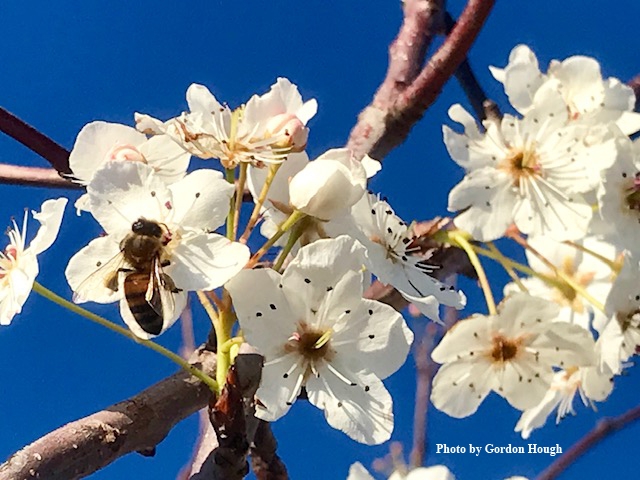
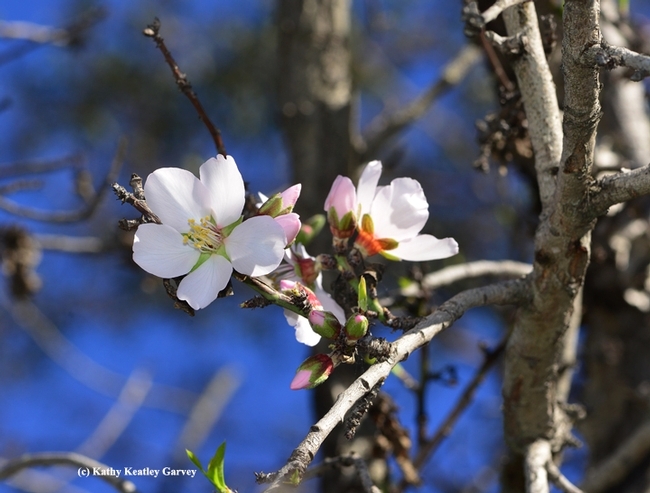
- Author: Kathy Keatley Garvey
It's almond pollination season in California but the weather refuses to cooperate.
Heavy rains, high winds, intense flooding. What are the bees to do?
They're holed up in their hives, waiting for the sun breaks. When the rain stops pelting their hives and the temperature climbs to 50 or 55 degrees, they poke their heads out. Let's go, girls!
Such was the scenario today when we went for a drive along Pleasants Valley Road in Vacaville, Solano County. Feral almond trees, storm-battered but stubbornly bracing for more, are blooming, and those bees--those glorious bees--are back.
The statistics are a bit overwhelming. California now has one million commercial acres of almonds. It takes two colonies per acre to pollinate them. Without bees, no almonds. With beekeepers reporting winter losses of 40 to 60 percent, what's the situation?
"What does that mean for the bee supply for almond pollination?" asks pollination guru Gordon Wardell in the current edition of Project Apis m (PAm). The organization's name comes from Apis mellifera, the scientific name for the European honey bee. "At present, while individual beekeepers' numbers appear to be down, there doesn't appear to be a shortage of colonies for almond pollination this year. While the supply might be tight, I don't foresee major shortages. Rental prices are up this year, averaging $170 to $185 per colony. This is $10 to $15 over rental prices last year. These prices are fair increases considering the amount of feeding needed to ready the colonies for February pollination and the increases in transportation costs."
Wardell, chair of PAm's board of directors and the 2016 recipient of the California State Beekeepers' Association's Distinguished Service Award, knows bees, knows almonds, and knows pollination. A professional apiculturist for more than three decades and now director of pollination operations for Wonderful Orchards, he's a former Extension apiculturist for the state of Maryland. His research includes developing Mega-Bee, the honey bee nutritional supplement. He's authored numerous publications on honey bees. His expertise covers Varroa mite control, honey bee nutrition, fire ant monitoring, small hive beetle, Africanized honey bees, and many other topics.
Wardell describes what's happening in California now as "the greatest commercial pollination event in the world."
Because it is. Billions of bees pollinating a million acres of almonds.
On a minuscule scale, it's still marvelous to see a dozen bees foraging on a single feral almond tree...doing what bees do.
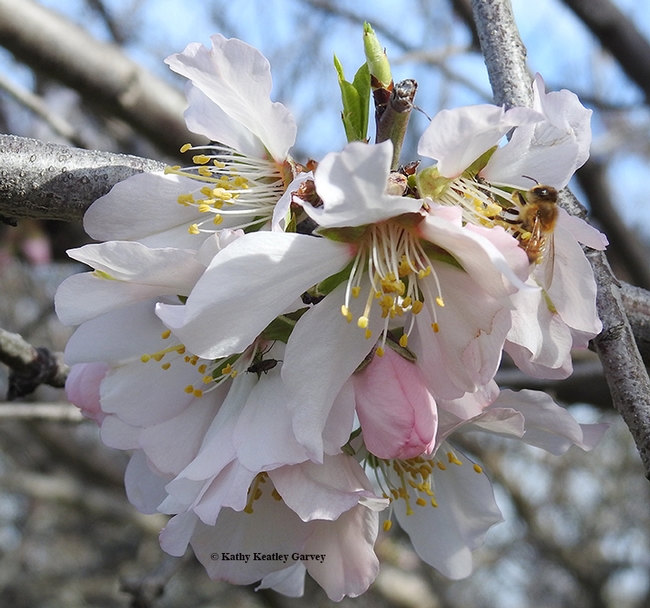
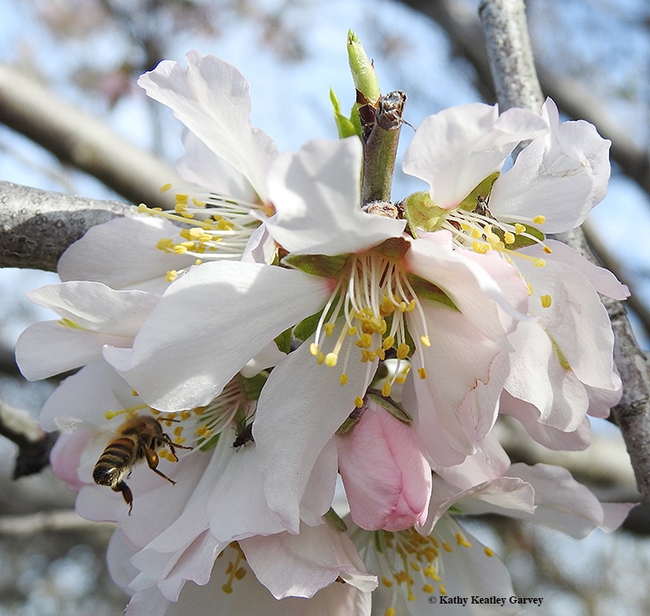
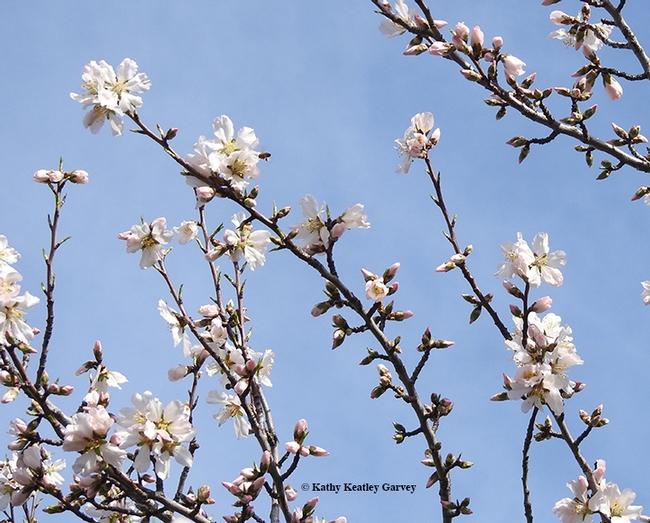
- Author: Kathy Keatley Garvey
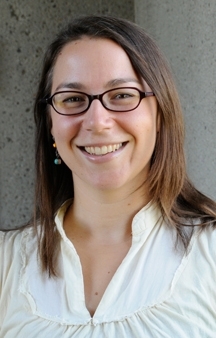
You're in luck. Two almond field days-- one set Thursday, March 10 in Lost Hills, Kern County, and the other on Tuesday, March 15 in Zamora, Yolo County--are scheduled and you're invited. They're free to all interested persons and no reservations are required, says coordinator Katharina Ullmann, crop pollination specialist for the Xerces Society for Invertebrate Conservation who holds a doctorate in entomology (Neal Williams lab) from UC Davis.
UC Davis pollination ecologists and other experts will be among those speaking.
For the March 10th event, titled “Almond Field Day: Integrated Crop Pollination,” participants will meet from 9 to 11 a.m. in an orchard east of Highway 33, about 5.8 miles north of the intersection between Highway 37 and Highway 36, Ullmann said. Signs will guide the way.
“This field day will provide an overview of integrated crop pollination for almonds,” Ullmann said. Topics will include almond pollination, minimizing risks to pollinators during bloom, and research updates on blue orchard bees and wildflower plantings for almond pollination in Kern County. The field day will include a tour of an orchard integrating honey bees, blue orchard bees, and wildflower plantings.
The speakers at the March 10th field day:
9 a.m.: Welcome by David Haviland, UC Cooperative Extension, Kern County, and Gordy Wardell, manager of pollination operations Wonderful Orchards, formerly Paramount Farms
9:10: Integrated crop pollination and almonds by pollination ecologist Neal Williams, associate professor, UC Davis, and Katharina Ullmann, crop pollination specialist, Xerces Society
9:25: Blue Orchard Bee research update by Natalie Boyle, postdoctoral researcher, U. S. Department of Agriculture's Agricultural Research Service (USDA-ARS)
9:45: Wildflower plantings for almond pollination by Neal Williams
10:05: Reducing risks to honey bees for almond pollination by Gordy Wardell, Wonderful Orchards
10:25: Mating disruption for navel orangeworm by Brad Higbee, director of entomology research, Wonderful Orchards
10:45: Technical and financial support, Nikki Smith, soil conservationist, USDA's Natural Resources Conservation Service (NRCS)
Sponsors are the UC Agriculture and Natural Resources, UC Davis, Integrated Crop Pollination Project, Xerces Society for Invertebrate Conservation, Wonderful Orchards, and USDA's NRCS.
For the March 15th event, titled “Almond Pollination and Orchard Pollinator Planters,” all interested persons will gather from 9 a.m. to 11 a.m. at 8304 County Road 91B, Zamora.
“This field day will provide an overview of integrated crop pollination and on-farm wildflower plantings for almonds in the Sacramento Valley,” Ullmann said. “We will hear the latest research from a UC Davis lab studying almond pollination and wildflower plantings, learn about almond pollinators and how to support those pollinators using wildflowers. We will also discuss establishment and maintenance practices for planting habitat on field crop edges and provide an overview of plant species appropriate for plantings in the Sacramento Valley and beyond. Two growers will share their perspectives.
The March 15th lineup:
9 a.m.: Welcome by Kat Pope, orchard advisor, UC Cooperative Extension, Sacramento, Solano and Yolo counties; and Rachael Long, owner of the DH Long Farm and Yolo County farm advisor
9:10: Integrated crop pollination, almond pollination and research update by Kimiora Ward, research associate, Neal Williams lab, UC Davis; Ola Lundin, postdoctoral researcher, Williams Lab, and Katharina Ullmann, crop pollination specialist, Xerces Society
9:40: Almond wildflower plantings 101 (DH Long Farm) by Kimiora Ward, research associate, Williams lab; Kitty Bolte, junior research specialist, Williams lab; and Tom Barrios, Barrios Farms
10:25: Solarization for wildflower planting success (Tadlock Farm) by Jessa Kay Cruz, pollinator conservation specialist, Xerces Society; orchard manager, Tadlock Farm
10:45: Technical and financial support, Ha Troung, Yolo County NRCS
The sponsors include UC Agriculture and Natural Resources, UC Davis, Xercies Society, Integrated Crop Pollination Project Colusa County Resource Conservation District, and the Yolo County Resource Conservation District.
Continuing Education Credit (CEC) will be given. Participants at the almond field days are asked to bring a hat, sunscreen and good walking shoes. For more information contact Katharina Ullmann at katharina@xerces.org or at (530) 302-5504.
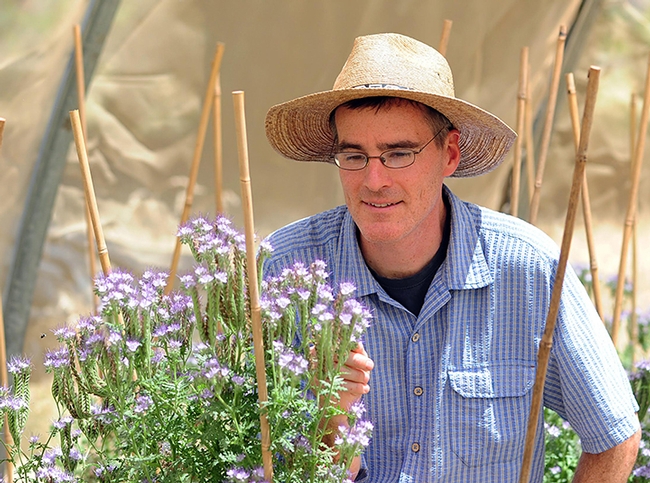
- Author: Kathy Keatley Garvey
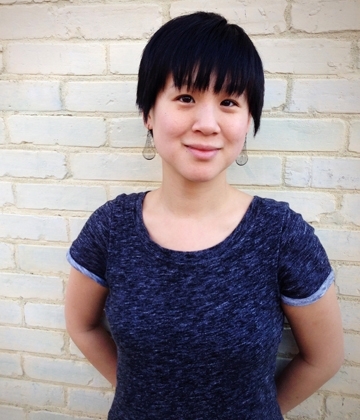
She's the beekeeper/graduate student at Harvard's Graduate School of Design who traveled through almond orchards in California's Sacramento and San Joaquin valleys in May 2014 to illustrate and pen a book about the spatial relationship between honey bees and almonds.
We wrote about her in a Feb. 11th Bug Squad blog.
The book, "Almond and the Bee," is now a reality. See http://blur.by/1CmYr3h. She's offering the book at cost ($9) and donating about $2 from the sale of each book to benefit the bees. The benefactor will be either the Xerces Society or Project Apis m.
Stephanie, a master of landscape architecture candidate who keeps bees on the rooftop of her school building, shared her marvelous 46-page digital story, http://almondandbee.com, with us earlier this year.
"I was inspired to create socially engaging and ecological performative places and hope to bring my passion for enhancing natural systems to the urban environment," she told us. "As a designer, I developed an interest in pollination during my second semester at the Harvard Graduate School of Design--I used the idea of pollination to attract people and pollinators to a park redesign, and developed a planting palette and a promenade that would do so."
Stephanie received a grant to finance her project. She spent a week in "almond country," meeting with experts at UC Berkeley and UC Davis, the Almond Board, the Blue Diamond Cooperative, beekeepers, almond growers, and almond growers/beekeepers.
Pollination ecologist Neal Williams, associate professor, UC Davis Department of Entomology and Nematology, was among those who sat down with her and talked almonds and bees. He filled her on his research and offered tips on people to meet and places to see.
"The shape of the project developed during my fall 2014 semester," she related. "I thought an illustrated story would allow me to combine my photographs, maps, and drawings, with found historical images in an engaging and accessible form...The story is about how that came to be, but it's also an argument for holistic thinking in agriculture that could be both cultural and economically significant."
Two key sentences on the first page of http://almondandbee.com beckon the reader: "The almond and the bee. The spatial relationship of the orchard, bee, and dwelling through time."
Almonds and bees need each other, she points out. California has more than 900,000 acres of almonds, and each acre requires two colonies for pollination. And every year some 1.6 million colonies, or approximately 60 percent of the nation's colonies, are trucked to California.
"The relationship between almond growers and migratory beekeepers are in many ways analogous to that of the fruit tree and the bee—one is sedentary and one is mobile, but both depend on one another," Stephanie writes.
In her book, she traces the modern history of the honey bee, touches on traditional beekeeping methods, mentions the invention of the Langsroth hive in 1851, and takes a peek at the future of beekeeping and almond orchards.
In February 2015 we described it as "an informative, creative and well-designed (digital) story." Now it's March 2015 and it's 'an informative, creative and well-designed book," with proceeds aimed at helping our troubled honey bees.
Well done, Stephanie!
